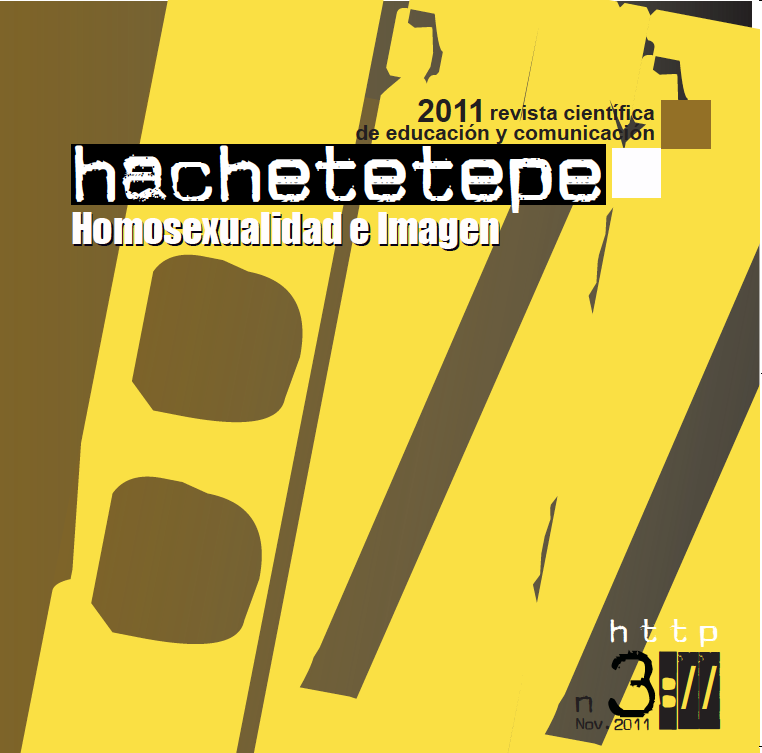Formaciones visuales indentitarias: femenidad y homosexualidad en la cultura visual

Información
Resumen
Contar con formación visual no es lo más común, pero tampoco es habitual tener identidad, al menos, reconocerla y reconocérsela. Las culturas están confeccionadas por una serie de elementos que la constituyen e identifican en relación a sí misma y con respecto a las otras. Mirar a la feminidad y homosexualidad en la cultura visual ha de ser un logro que nos/les determine; teniendo a la cultura audiovisual en cuestión y, dentro de este parámetro, hemos de tener presente la homosexualidad y la feminidad.
Palabras clave
Descargas
Cómo citar
Licencia

Esta obra está bajo una licencia internacional Creative Commons Atribución-NoComercial-SinDerivadas 4.0.
Aquellos autores/as que tengan publicaciones con esta revista, aceptan los términos siguientes:
- Conservarán sus derechos de autor y garantizarán a la revista el derecho de primera publicación de su obra, el cual estará simultáneamente sujeto a la Licencia de reconocimiento de Creative Commons. Se pueden copiar, usar, difundir, transmitir y exponer públicamente, siempre que se cite la autoría, la url, y la revista, y no se usen para fines comerciales. No se permite hacer obras derivadas.
- Podrán adoptar otros acuerdos de licencia no exclusiva de distribución de la versión de la obra publicada (p. ej.: depositarla en un archivo telemático institucional o publicarla en un volumen monográfico) siempre que se indique la publicación inicial en esta revista.
- Difundir su obra a través de Internet (p. ej.: en archivos telemáticos institucionales o en su página web) una vez que el manuscrito sea aceptado, lo cual puede producir intercambios interesantes y aumentar las citas de la obra publicada. (Véase El efecto del acceso abierto)
Hachetetepé. Revista científica de educación y comunicación no cobra honorarios ni por la presentación de manuscritos ni por la publicación de sus artículos.
Citas
Alegre, M. S. P. (2001). “Reflexões sobre Iconografia etnográfica”. En Feldman-Bianco, B y Leite, M. (Orgs). Desafios da Imagem: fotografia, iconografia e vídeo nas ciências sociais. Campinas: Papirus.
Barthes, R. (1984). A Câmera Clara. Rio de Janeiro: Nova Fronteira
Barthes, R. (1989). Mitologias. Rio de Janeiro: Bertand Brasil
Barthes, R. (1990). O Óbvio e o Obtuso. Rio de Janeiro: Nova Fronteira.
Bauer, M e Gaskell, G. (2000): Pesquisa Qualitativa com Texto, Imagem e Som: um manual prático. Petrópolis:
Vozes.
Burity, J. A. (2001). “Identidade e Múltiplo Pertencimento nas Práticas Associativas Locais”. En Cadernos de Estudos Sociais. (17) 2; 189-228.
Duncun, P. (2003). “Visual Culture in the Classroom”. En Art Education; Marzo de 2003; 25-32.
Eckert, C. (Orgs) (1999): Imagem em Foco: novas perspectivas em antropologia. Porto Alegre: UFRGS.
Essus, A.M. (1994). “Através da Imagem I: possibilidades teórico-metodológicas para o uso da fotografia como recurso didático, uma experiência acadêmica”.
En Primeiros Escritos, 1, Niterói. UFF; 4.
Galano, A. M. (2001). “Iniciação a pesquisa com Imagem”.En Feldman-Bianco, B., Leite, M. y Moreira L.(Orgs). Desafios da Imagem: fotografia, iconografia e vídeo nas ciências sociais. Campinas: Papirus.
Gombrich, E.H. (1978). Simbolic Images – Studies in the art of Renaissance II. New York: Phaidon Press.
Hernández, F. (2000). Cultura visual, mudança educativa e projeto de trabalho. Porto Alegre: Artmed.
Jenks, Ch. (1999). The Centrality of the Eye in Western Culture. En An Introdution to Visual Culture. London and New York.
Kornis, M. (1991). “História e Cinema: um debate metodológico”. Em Estudos Históricos. 10; 237-150.
Le Goff, J. (1985). “Documento/monumento”. En Memória e História. SP: Ed. Unicamp; 548.
Le Goff y otros. (1997). en Annales: Histoire, Sciences Sociales. (52) 3.
Mignot-Lefebvre, Y. (1987). “L`approche audio-visuale des phénomènes dìnnovation sociale”. En Pratiques audio-visuale em sociologie. Nantes: LERSCO CNRS.
Monte-Mor, P. “No Garimpo do nitrato: a experiência da mostra internacional do filme etnográfico”. En Feldman-Bianco, B.; Leite, M. y Moreira Leite, L. (2001) (Orgs). Desafios da Imagem: fotografia, iconografia e vídeo nas ciências sociais. Campinas: Papirus.
Mirzoeff, N. (1999). An Introdution to Visual Culture. London and New York.
Mirzoeff, N. (2003). Una Introducción a la cultura visual. Barcelona: Paidós. 2
Monteiro, A.M. (2005). “Ensino de História e história cultural: diálogos possíveis”. En Bicalho, M.F.; Soihet, R. y Azevedo, C. Culturas Políticas: pesquisa e ensino de história. RJ: Mauad/Faperj; 439- 459.
Peixoto, Cl. (2001). “Caleidoscópio de Imagens: o uso do vídeo e sua contribuição à análise das relações sociais. En Feldman-Bianco, B.; Leite, M. y Moreira Leite, L. (ORGs). Desafios da Imagem: fotografia, iconografia e vídeo nas ciências sociais. Campinas: Papirus
Pollak, M. (1992). “Memória e Identidade Social”. Em Estudos Históricos, 10; 200-212.
Ricoeur, P. (2000). La mémoire. L’histoire. L’oubli. Paris: Seuil.
Santos, B. (1995). “A construção multicultural da igualdade e da diferença”. VII Congreso de SBS. Rio de Janeiro.
Santos, B (1994). “Modernidade, identidade e cultura de fronteira”. Revista de Sociologia da USP Tempo Social. 12; 120-130.
Sardelich, M. E. (2006). “Leitura de Imagens e cultura visual: desenredando conceitos para a prática educativa”. Educar. 27; 214.
Slater, D. (1999). Potography and Modern Vision. In An Introdution to Visual Culture. London and New York.
Silva, S. (2003). O Singular e o Plural da Política: um estudo teórico sobre a esfera publica e o ideário da democracia na sociedade global. Tese de doutoramento.
Florianópolis.Programa de Pós Graduação Interdisciplinar em Ciências Humanas.
Velho, G. (1994). “Memória, identidade e projeto”. En Projeto e metamorfose. Antropologia das sociedades
complexas. Rio de Janeiro: Jorge Zahar Editor.
Voronia, T. (1989). “International Symposium - Visual traditions-folk traditions”. En Visual Antropology, 1.

